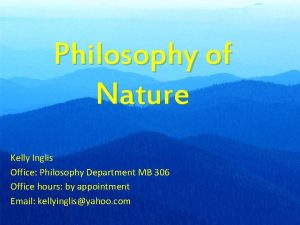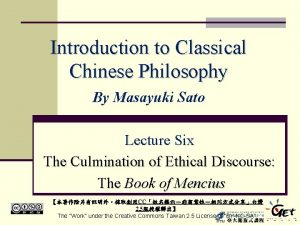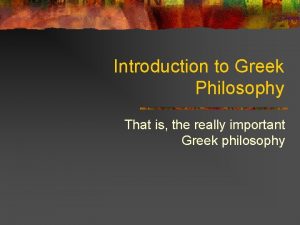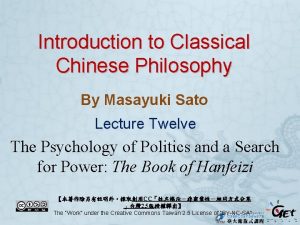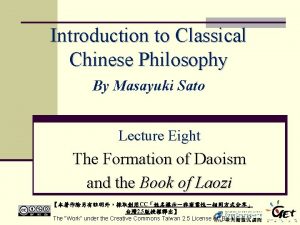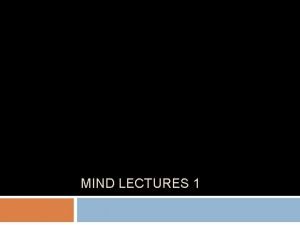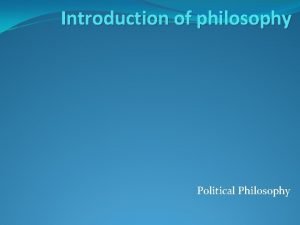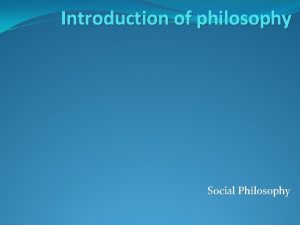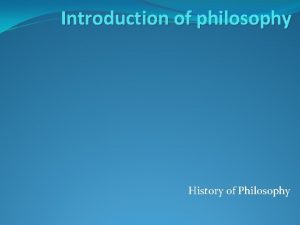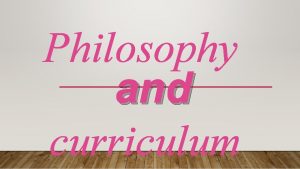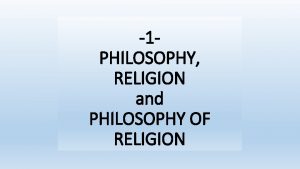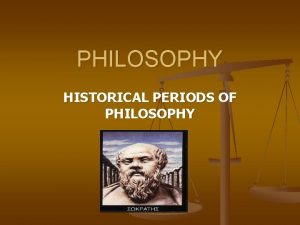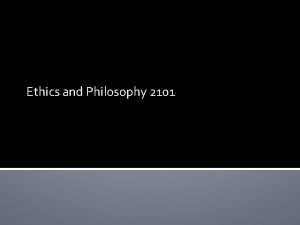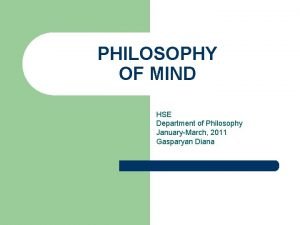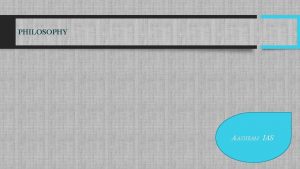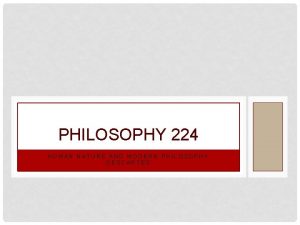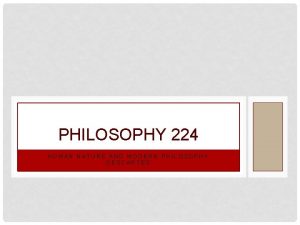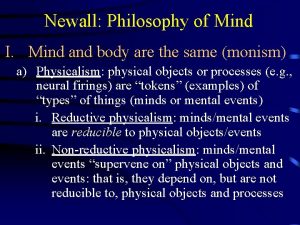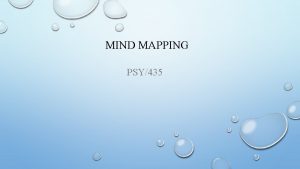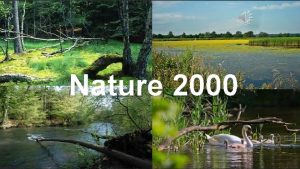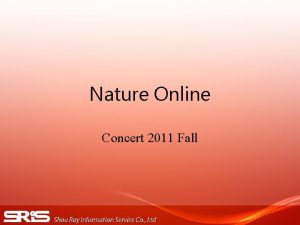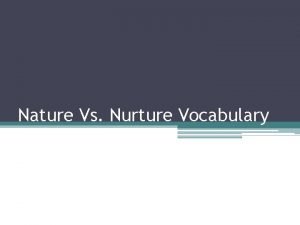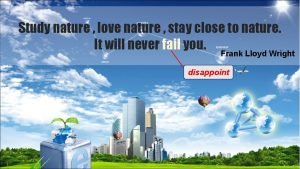The Nature of Mind Introduction Philosophy of Mind





































- Slides: 37

The Nature of Mind • • • Introduction Philosophy of Mind Cognitive Models Machine Intelligence Life and Cognition • • • The Brain Dreams and Emotions Language Modern Physics Consciousness 1

THE FACTORY OF ILLUSIONS • Mind = cognition + consciousness • Cognition is ubiquitous in nature • The mind translates a world of particles and waves into a world of colors, sounds and smells 2

TERMINOLOGY/ CONSCIOUSNESS AND MIND • Every conscious state is mental. • Is every mental state also conscious? • What is the mind? – The set of all brain processes – The set of all conscious processes – Something in between • Mental faculties: the mechanism that allows a piece of living matter to remember or learn something (in the sense of being able to perform future actions based on it) + the awareness of remembering or learning something • Mental properties = properties of matter + properties of consciousness • Mind = cognition + consciousness 3

CONSCIOUSNESS • Consciousness is a natural phenomenon. If our theory of the universe does not explain consciousness, then maybe we do not have a good theory of the universe. 4

? • How does conscious experience arise from the brain’s electrochemical activity? • Why can't I be aware of my entire being? We only have partial introspection. We have no idea of what many organs are doing in our body. • We can only be conscious of one thing at a time. There are many things that we are not conscious of. How do we select which thing we want to be conscious of? • Why can I only feel my own consciousness and not other people's consciousness? Why can't I feel other people's feelings? Why can't anybody else feel my feelings? 5

? • Consciousness is a whole, unlike the body which is made of parts. Conscious states cannot be reduced to more elementary units. • Why are we conscious? • How did consciousness evolve? Did it evolve from nonconscious matter? • What is the self? My body changed over the years, and my brain too. Therefore my mind may have changed too. But the self bestows unity. 6

? • Are other people conscious the same way I am? Are some people more conscious and others less conscious? Are some animals also conscious? Are all animals conscious? Are plants conscious? Can non-living matter also be conscious? Is everything conscious? • Can things inside conscious things be conscious? Are planets and galaxies conscious? Are arms and legs conscious? 7

QUALIAS VS SENSES – Clarence Lewis • ”Qualia” are subjective, directly perceived and known in an absolute way • Matter is “inscrutable” • We know what consciousness is because we feel it, but we cannot "sense" it • We know what matter is because we sense it, but we cannot "feel" it • If i believe my immediate perceptions, there is red. If i try to make sense of my perceptions, i have to work out a theory of nature according to which there is no red 8

TERMINOLOGY • • Consciousness (awareness) Self (awareness of lasting in space and time) Sensations (bodily feelings such as pain, red, warmth) Emotions (phenomenal feelings such as anger, happiness, fear, love) • Cognition (processes that result in reasoning, memory, learning, etc. ), • Perception (the physical process of perceiving the world) • Thought (what you are doing right now) 9

DEGREES OF CONSCIOUSNESS • Degrees of consciousness? • The behavior of teenagers depends on parental guidance, role models, peer pressure and marketing campaigns • "Freaks" are teens who are more conscious • Adults tend to behave according to guidelines • "Eccentrics" are adults who are more conscious • Consumers tend to like what they have been told to like • “Contrarians” are consumers who are more conscious 10

THE IMPOSSIBILITY OF A SCIENCE OF CONSCIOUSNESS • Karl Lashley: the mind is never conscious (When I think about myself, I am not conscious of what my brain is doing) • Thomas Nagel: what it is like to be a bat? • Frank Jackson: the color-blind neuroscientist 11

THE IMPOSSIBILITY OF A SCIENCE OF CONSCIOUSNESS • Colin Mc. Ginn: – Consciousness does not belong to the "cognitive closure" of our organism – Understanding our consciousness is beyond our cognitive capacities – "Mind may just not be big enough to understand mind” – Objection: “Cognitive closure” changes during the course of a lifetime – Objection: “Cognitive closure” has evolved over the centuries 12

THE PROCESS OF CONSCIOUSNESS • William James: – Consciousness is not an entity, but a function – Consciousness is an operation rather than a thing – Consciousness is not only awareness of the world, but also of the self 13

THE DYNAMICS OF CONSCIOUSNESS • The location of consciousness – Space-based binding (Damasio’s convergence zones, Edelman's reentrant maps) – Time-based binding (Gray & Koch, Llinas, Crick) • The process of consciousness • The ontogenesis of consciousness • The phylogenesis of consciousness 14

SPACE-BASED BINDING • ANTONIO DAMASIO – The assembly (“binding”) of consciousness requires more than a working memory: a system of "convergence zones” – “Movie in the mind” consciousness (how a number of sensory inputs are transformed into the continuous flow of sensations of the mind): • Constructed from sensory mappings • First order narrative of sensory mappings • Unchanged throughout a lifetime • Shared by other species • Purely non-verbal process 15

SPACE-BASED BINDING • DAMASIO – ”Self" consciousness • Topography of the body • Topography of the environment • Self vs nonself • Second-order narrative in which the self is interacting with the non-self • An "owner" and "observer" of the movie is created • Verbal process • Body's homeostasis (continuity of the same organism) • The self is continuously reconstructed • The "I" is not telling the story: the "I" is created by stories told in the mind • "You are the music while the music lasts” (Eliot) 16

SPACE-BASED BINDING • GERALD EDELMAN – The brain refers to itself – Neurons get organized by experience in maps (categories) – Primary consciousness (being aware of the world) • Two kinds of nervous system. . . • 1. Memory continuously reorganizes (“recategorizes”) • 2. Learning as ranking of stimuli ("value-laden" memory, instinctive behavior) • “Intelligent” behavior + "instinctive" behavior • Primary consciousness arises from "reentrant loops" that interconnect "perceptual categorization" and "value-laden" memory ("instincts") 17

SPACE-BASED BINDING • EDELMAN – Higher-order consciousness (language and self-awareness) • Distinction between the self and the rest of the world • Social interaction… anatomical changes …phonology… …permanent categories. . . Semantics. . . Syntax • Unique to humans 18

TIME-BASED BINDING • Christof Koch (1989) – Very large number of neurons oscillate in synchrony – Only one pattern is amplified into a dominant 40 hz oscillation • Charles Gray – The memory of something is generated by a stream of oscillating networks – Brain regions send out nervous impulses at the same frequency – The perception of an object is created by the superimposed oscillation – The brain uses frequency as a means to integrate separate parts of a perception – The limited capacity of the brain can handle the overwhelming amount of objects that the world contains 19

TIME-BASED BINDING • Rodolfo Llinas – A scanning system that sweeps across all regions of the brain every 1. 25 thousandths of a second (40 times a second) – Sent out from the thalamus and triggers all the synchronized cells in the cerebral cortex that are recording sensory information – The cells then fire a coherent wave of messages back to the thalamus. – Only cortex cells that are active at that moment respond to the request from the thalamus. – Consciousness originates from the constant interaction between the thalamus and the cortex – Every function in the body is controlled by a rhythmic system that occurs automatically 20

TIME-BASED BINDING • Francis Crick • Erich Harth 21

DARWINIAN CONSCIOUSNESS • Gazzaniga • Ornstein – Multimind • Dennett/Blackmore – Memes create the mind • Calvin – Cerebral code • Greenfield – Competition of gestalts 22

The social brain • Michael Gazzaniga (1985) – Independent systems work in parallel – Evolutionary additions to the brain – Many minds coexist in a confederation – A module located in the left hemisphere interprets the actions of the other modules and provides explanations for our behavior – Beliefs do not preceed behavior, they follow it: behavior determines our beliefs – It is only by behaving that we conceptualize our selves – There are many "i"'s and one "i" that makes sense of what all the other "i"'s are doing – The verbal self keeps track of what the person is doing and 23 interprets reality

The multimind • Robert Ornstein (1986) – Many minds each operating independently and each specialized in one task – The body contains many centers of control – The brain is a confederation of more or less independent brains – A “mind” is an adaptive system that has been shaped by the world – “Minds” develop in a Darwinian manner – “Minds” compete for control of the organism – I am many persons but at any point in time I am aware of only one of them 24

Mental darwinism • William Calvin (1991) – A Darwinian process in the brain finds the best thought from the many that are continuously produced – Cerebral code (is the anologue of the genetic code which) allows for reproduction and selection of thoughts – A cerebral code copies itself repeatedly around a region of the brain – “Thoughts” compete and evolve subconsciously – Only some of them result in action – Thoughts are movements that haven't happened yet – Thought arises from the copying and competition of cerebral codes 25

Mental darwinism • William Calvin (1991) – Dreaming occurs all the time but we can't see them when we are awake – Our actual thought is simply the dominant pattern in the copying competition – Circuits in the cerebral cortex act as copying machines – Variants compete for cortex space 26

THEATRE OF CONSCIOUSNESS • Bernard Baars – Independent intelligent agents that broadcast messages to each other through a common workspace – Conscious experience emerges from cooperation and competition 27

THE DREAM OF CONSCIOUSNESS • Consciousness may simply be a manifestation of the same process that creates dreams • Jonathan Winson: – Dreams were helping us survive before mind was invented – The mind as an evolution of dreaming – First the brain started dreaming, then dreams took over the brain and became the mind – The mind as one long, continuous dream of the universe • Allan Hobson – The interplay of two chemical processes is responsible for all of consciousness – Both chemical systems are always active – Conscious states fluctuate continuously between waking and dreaming 28

ECOLOGICAL CONSCIOUSNESS • George Herbert Mead (1934) – Consciousness is not a separate substance, but the world in its relationship with the organism – Consciousness is in the world, outside the organism – Objects of the environment are colored, beautiful, etc: that "is" consciousness – Objects do not exist per se, they are just the way an organism perceives the environment – It is our acting in the environment that determines what we perceive as objects – Different organisms may perceive different objects – The environment results from the actions of the organism – We are actors as well as observers (of the consequences of 29 our actions)

ECOLOGICAL CONSCIOUSNESS • George Herbert Mead (1934) – Any change in the organism results in a change of the environment. – Those objects have qualities and values that constitute what we call "consciousness" – Consciousness is not a brain process: the switch that turns consciousness on or off is a brain process – Consciousness is pervasive but only social species can report on their conscious experiences – A self always belongs to a society of selves 30

CONSCIOUSNESS • TOR NORRETRANDERS – CONSCIOUSNESS IS MOSTLY ABOUT WHAT HAPPENS INSIDE US, NOT WHAT HAPPENS OUTSIDE – CONSCIOUS (THINKING) "I" VS ACTING (INSTINCTIVE) "ME” • MARCEL KINSBOURNE – CONSCIOUSNESS "IS" PERFORMANCE – THE BRAIN DOES NOT GENERATE CONSCIOUSNESS: IT IS CONSCIOUS 31

SELF • Derek Parfit – What happens to a person who is destroyed by a scanner in London and rebuilt cell by cell in New York by a replicator that has received infinitely detailed information from the scanner about the state of each single cell, including all of the person's memories? – Is the person still the same person? – Or did the person die in London? 32

SELF • Lazarus: differentiation of self and other is a fundamental property of living organisms • Neisser: five kinds of self • Carlson: every act of perception specifies both a perceiving self and a perceived object • Nagel: consciousness cannot be "counted” • Ornstein: identity is an illusion • Dennett: consciousness is simply the feeling of the overall brain activity • Gazzaniga: consciousness is an ex-post facto interpreter • Parfit: the self "is" the brain state 33

SELF • Every year 98% of the atoms of your body are replaced • Parfit’s rebuilt self • How can reality be still the same as we grow up 34

FREE WILL • Do we think or are we thought? – We are simply machines programmed by the rest of the universe (eg, relativity) – Consciousness fabricates reality (eg, quantum theory) • Can a brain process occur that is not completely caused by other physical processes? • Does matter have a degree of control over its own motion? 35

FREE WILL • BERNARD – The purposiveness of living organisms is a consequence of evolution by natural selection – Inanimate matter obeys newton's laws of cause and effect, animate matter tends to maintain its state no matter what external forces are applied – The "purposeful" behavior of a living organism is the reaction to environmental forces – Living bodies appear to act purposedly, but they are simply reacting to the environment 36

Who I Am • Piero Scaruffi – – – – – Degree in Math/Physics (“Scientific” background) Career in Cognitive Science (“Philosophical” background) Career as Music/Cinema/Fiction critic (“Artistic” background) Traveled to 83 countries (“History”) Published 15 books Latest: “Thinking About Thought” (2003) www. scaruffi. com www. thymos. com E-mail: editor@scaruffi. com 37
 Nature of philosophy
Nature of philosophy Empiricism and the philosophy of mind
Empiricism and the philosophy of mind Mohist mechanism
Mohist mechanism An introduction to greek philosophy
An introduction to greek philosophy Introduction to classical chinese philosophy
Introduction to classical chinese philosophy Introduction to classical chinese philosophy
Introduction to classical chinese philosophy Nature and nature's laws lay hid in night
Nature and nature's laws lay hid in night Determinace lidské psychiky
Determinace lidské psychiky Hình ảnh bộ gõ cơ thể búng tay
Hình ảnh bộ gõ cơ thể búng tay Slidetodoc
Slidetodoc Bổ thể
Bổ thể Tỉ lệ cơ thể trẻ em
Tỉ lệ cơ thể trẻ em Gấu đi như thế nào
Gấu đi như thế nào Glasgow thang điểm
Glasgow thang điểm Bài hát chúa yêu trần thế alleluia
Bài hát chúa yêu trần thế alleluia Kể tên các môn thể thao
Kể tên các môn thể thao Thế nào là hệ số cao nhất
Thế nào là hệ số cao nhất Các châu lục và đại dương trên thế giới
Các châu lục và đại dương trên thế giới Công thức tính thế năng
Công thức tính thế năng Trời xanh đây là của chúng ta thể thơ
Trời xanh đây là của chúng ta thể thơ Cách giải mật thư tọa độ
Cách giải mật thư tọa độ Làm thế nào để 102-1=99
Làm thế nào để 102-1=99 Phản ứng thế ankan
Phản ứng thế ankan Các châu lục và đại dương trên thế giới
Các châu lục và đại dương trên thế giới Thơ thất ngôn tứ tuyệt đường luật
Thơ thất ngôn tứ tuyệt đường luật Quá trình desamine hóa có thể tạo ra
Quá trình desamine hóa có thể tạo ra Một số thể thơ truyền thống
Một số thể thơ truyền thống Cái miệng xinh xinh thế chỉ nói điều hay thôi
Cái miệng xinh xinh thế chỉ nói điều hay thôi Vẽ hình chiếu vuông góc của vật thể sau
Vẽ hình chiếu vuông góc của vật thể sau Biện pháp chống mỏi cơ
Biện pháp chống mỏi cơ đặc điểm cơ thể của người tối cổ
đặc điểm cơ thể của người tối cổ Thế nào là giọng cùng tên
Thế nào là giọng cùng tên Vẽ hình chiếu đứng bằng cạnh của vật thể
Vẽ hình chiếu đứng bằng cạnh của vật thể Vẽ hình chiếu vuông góc của vật thể sau
Vẽ hình chiếu vuông góc của vật thể sau Thẻ vin
Thẻ vin đại từ thay thế
đại từ thay thế điện thế nghỉ
điện thế nghỉ Tư thế ngồi viết
Tư thế ngồi viết
